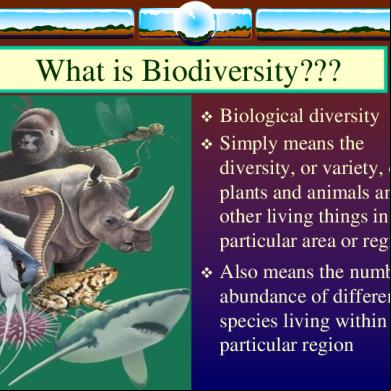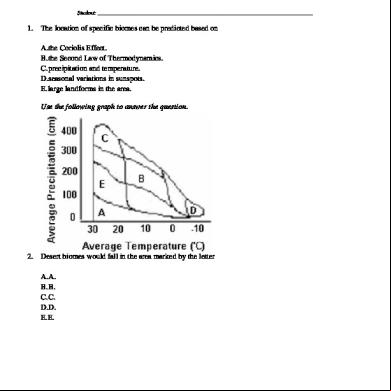Biodiversity And Classification Nl l46d
This document was ed by and they confirmed that they have the permission to share it. If you are author or own the copyright of this book, please report to us by using this report form. Report 445h4w
Overview 1s532p
& View Biodiversity And Classification Nl as PDF for free.
More details 6h715l
- Words: 1,016
- Pages: 23
What is Biodiversity??? Biological diversity Simply means the diversity, or variety, of plants and animals and other living things in a particular area or region
Also means the number, or abundance of different species living within a particular region
Okay, So Why Is It Important?
Everything that lives in an ecosystem is part of the web of life, including humans
Each species of vegetation and each creature has a place on the earth and plays a vital role in the circle of life
Plant, animal, and insect species interact and depend upon one another for what each offers, such as food, shelter, oxygen, and soil enrichment
"It is reckless to suppose that biodiversity can be diminished indefinitely without threatening humanity itself." -Edward O. Wilson (Father of Biodiversity)
Early Classification
To study the diversity of life, biologists use a classification system to name organisms and group them in a logical manner. The field of Biology that deals with classifying organisms is called Taxonomy. Carolus Linnaeus is the father of Modern Taxonomy (1700’s) •Linnaeus is considered the founder of the binomial system of nomenclature and the originator of modern scientific classification of plants and animals
Linneaus’ Findings: Millions
of animals and plants How did we keep them in order? Binomial Nomenclature
Hierarchy System Of Classification Hierarchy Ranking System
Kingdom
Phylum
Class
Order
Family
Genus
Species
Binomial Nomenclature Identifying organisms by their genus and species’ names 2 words First letter of FIRST word is capital, First letter of SECOND word is lowercase. The word needs to be in italic or underlined Latin Form of the word. Ex: Homo sapiens, Acer rubrum, Canus lupus Humans, Red Maple, Wolf
Binomial Nomenclature Used because the common name can sometimes be misleading. Common names can be different in various parts of the world (for example the British, North American and Australian “Robins”) Latin is a universal “dead” language
How do Scientist Classify organisms?
You will probably need to add this slide to your notes Characteristics that appear in recent parts of a lineage but not in its older are called derived characters. Derived Characters can be used to construct a Cladogram, a diagram that shows the evolutionary relationship among a group of organism This concept was derived from Darwin. http://ccl.northwestern.edu/simevolution/obonu/cladograms/Op en-This-File.swf
How do Scientist Classify organisms? Early systems of classification grouped organisms together bases on visible similarities. That can quickly lead to troubles…. Biologist now group organisms into categories that represent lines of evolutionary descent, or phylogeny, not just physical similarities. Characteristics that appear in recent parts of a lineage but not in its older are called derived characters. This concept was derived from Darwin.
How do Scientist Classify organisms? Similarities at the DNA level in the genes of organisms can be used to help determine classification. Comparisons of DNA can also be used to mark the age of evolutionary time. A model known as a molecular clock uses DNA comparisons to estimate the length of time that two species have been evolving independently.
A dichotomous key is a series of yes/no questions that state the rules for placing items into categories within a system of classification Ex: Plants, Insects, Trees, People (We could make one for our class!!)
1. Eubacteria- (Bacteria) 2. Archaebacteria(Bacteria) 2. Protists- (Amoeba) 3. Fungi- (Mushrooms) 4. Plants- (Trees) 5. Animal- (Mammals)
2 Kingdoms or 1?
Most books lists 6 kingdoms, Eubacteria and Archaebacteria Prior to 1990 most books listed only 5 kingdoms, Eubacteria and Archaebacteria were grouped together Monera Either is correct..(I still refer to Monera on my quizzes and test. )
The Three-Domain System Molecular
analyses have given rise to a new taxonomic category that is now recognized by many scientist. The domain is more inclusive category than any other—larger than a kingdom. Bacteria, Archaea and Eukarya.
Eubacteria
Single Celled, Prokaryotic, Autotrophic and Hetrotrophic Most bacteria are in the EUBACTERIA kingdom. Cell walls with peptidoglycan. Some produce vitamins and foods like yogurt. Ex: Streptococcus, Escherichia coli
Bacteria…ecological diverse Free living soil organisms to deadly parasites Some need oxygen some do not need oxygen.
Archaebacteria
Single Celled Prokaryotic Autotrophic and Heterotrophic Cell walls do NOT contain peptidogllycan Ex: Methanogens, halophiles
These bacteria live in volcanic hot springs, brine pools, and black organic mud. Most survive in the absence of oxygen
Protists
Mostly unicellular Eukaryotic Autotrophic/Heterotrophic have great variety Ex: Amoeba (bottom) and Paramecium (top) You need to be familiar with BOTH of these little guys…they will be on your quiz/test.
Fungi
Mostly multicellular but some unicellular. Has a cell wall but does NOT make its own food. Heterotrophic Change dead organic matter into usable nutrients… Decomposers Ex: Bread mold, mildew, yeast, and mushrooms.
Plant Kingdom Green- contain chlorophyll Make food by photosynthesis Ex: Algae. Moss, Vascular Plants, Trees, Flower, Etc
Animal Kingdom Multi-Cellular Cannot make their own food Most animals move (sponge is sessile) Vertebrates: (Backbone) Ex: Fish, Frogs, Birds, Snakes, and US!! Invertebrates: (No backbone) Ex: Sponges, Jellyfish, Earthworm
A Mysterious Organism-Virus Not sure which classification to put viruses under No cell parts Chromosomelike structures Do not grow as living things
A Mysterious Organism-Virus 1.
A virus is an infectious organism that reproduces within the cells of an infected host.
2.
A virus is not alive until it enters the cells of a living plant or animal
3.
A virus contains genetic information wrapped in a protein coat.
4.
Viruses can be useful as well as harmful.
5.
6.
A virus that mutates ensures its own survival by making itself unrecognizable to immune systems and vaccines. Even viruses engineered for useful purposes can be harmful if unchecked
Also means the number, or abundance of different species living within a particular region
Okay, So Why Is It Important?
Everything that lives in an ecosystem is part of the web of life, including humans
Each species of vegetation and each creature has a place on the earth and plays a vital role in the circle of life
Plant, animal, and insect species interact and depend upon one another for what each offers, such as food, shelter, oxygen, and soil enrichment
"It is reckless to suppose that biodiversity can be diminished indefinitely without threatening humanity itself." -Edward O. Wilson (Father of Biodiversity)
Early Classification
To study the diversity of life, biologists use a classification system to name organisms and group them in a logical manner. The field of Biology that deals with classifying organisms is called Taxonomy. Carolus Linnaeus is the father of Modern Taxonomy (1700’s) •Linnaeus is considered the founder of the binomial system of nomenclature and the originator of modern scientific classification of plants and animals
Linneaus’ Findings: Millions
of animals and plants How did we keep them in order? Binomial Nomenclature
Hierarchy System Of Classification Hierarchy Ranking System
Kingdom
Phylum
Class
Order
Family
Genus
Species
Binomial Nomenclature Identifying organisms by their genus and species’ names 2 words First letter of FIRST word is capital, First letter of SECOND word is lowercase. The word needs to be in italic or underlined Latin Form of the word. Ex: Homo sapiens, Acer rubrum, Canus lupus Humans, Red Maple, Wolf
Binomial Nomenclature Used because the common name can sometimes be misleading. Common names can be different in various parts of the world (for example the British, North American and Australian “Robins”) Latin is a universal “dead” language
How do Scientist Classify organisms?
You will probably need to add this slide to your notes Characteristics that appear in recent parts of a lineage but not in its older are called derived characters. Derived Characters can be used to construct a Cladogram, a diagram that shows the evolutionary relationship among a group of organism This concept was derived from Darwin. http://ccl.northwestern.edu/simevolution/obonu/cladograms/Op en-This-File.swf
How do Scientist Classify organisms? Early systems of classification grouped organisms together bases on visible similarities. That can quickly lead to troubles…. Biologist now group organisms into categories that represent lines of evolutionary descent, or phylogeny, not just physical similarities. Characteristics that appear in recent parts of a lineage but not in its older are called derived characters. This concept was derived from Darwin.
How do Scientist Classify organisms? Similarities at the DNA level in the genes of organisms can be used to help determine classification. Comparisons of DNA can also be used to mark the age of evolutionary time. A model known as a molecular clock uses DNA comparisons to estimate the length of time that two species have been evolving independently.
A dichotomous key is a series of yes/no questions that state the rules for placing items into categories within a system of classification Ex: Plants, Insects, Trees, People (We could make one for our class!!)
1. Eubacteria- (Bacteria) 2. Archaebacteria(Bacteria) 2. Protists- (Amoeba) 3. Fungi- (Mushrooms) 4. Plants- (Trees) 5. Animal- (Mammals)
2 Kingdoms or 1?
Most books lists 6 kingdoms, Eubacteria and Archaebacteria Prior to 1990 most books listed only 5 kingdoms, Eubacteria and Archaebacteria were grouped together Monera Either is correct..(I still refer to Monera on my quizzes and test. )
The Three-Domain System Molecular
analyses have given rise to a new taxonomic category that is now recognized by many scientist. The domain is more inclusive category than any other—larger than a kingdom. Bacteria, Archaea and Eukarya.
Eubacteria
Single Celled, Prokaryotic, Autotrophic and Hetrotrophic Most bacteria are in the EUBACTERIA kingdom. Cell walls with peptidoglycan. Some produce vitamins and foods like yogurt. Ex: Streptococcus, Escherichia coli
Bacteria…ecological diverse Free living soil organisms to deadly parasites Some need oxygen some do not need oxygen.
Archaebacteria
Single Celled Prokaryotic Autotrophic and Heterotrophic Cell walls do NOT contain peptidogllycan Ex: Methanogens, halophiles
These bacteria live in volcanic hot springs, brine pools, and black organic mud. Most survive in the absence of oxygen
Protists
Mostly unicellular Eukaryotic Autotrophic/Heterotrophic have great variety Ex: Amoeba (bottom) and Paramecium (top) You need to be familiar with BOTH of these little guys…they will be on your quiz/test.
Fungi
Mostly multicellular but some unicellular. Has a cell wall but does NOT make its own food. Heterotrophic Change dead organic matter into usable nutrients… Decomposers Ex: Bread mold, mildew, yeast, and mushrooms.
Plant Kingdom Green- contain chlorophyll Make food by photosynthesis Ex: Algae. Moss, Vascular Plants, Trees, Flower, Etc
Animal Kingdom Multi-Cellular Cannot make their own food Most animals move (sponge is sessile) Vertebrates: (Backbone) Ex: Fish, Frogs, Birds, Snakes, and US!! Invertebrates: (No backbone) Ex: Sponges, Jellyfish, Earthworm
A Mysterious Organism-Virus Not sure which classification to put viruses under No cell parts Chromosomelike structures Do not grow as living things
A Mysterious Organism-Virus 1.
A virus is an infectious organism that reproduces within the cells of an infected host.
2.
A virus is not alive until it enters the cells of a living plant or animal
3.
A virus contains genetic information wrapped in a protein coat.
4.
Viruses can be useful as well as harmful.
5.
6.
A virus that mutates ensures its own survival by making itself unrecognizable to immune systems and vaccines. Even viruses engineered for useful purposes can be harmful if unchecked










